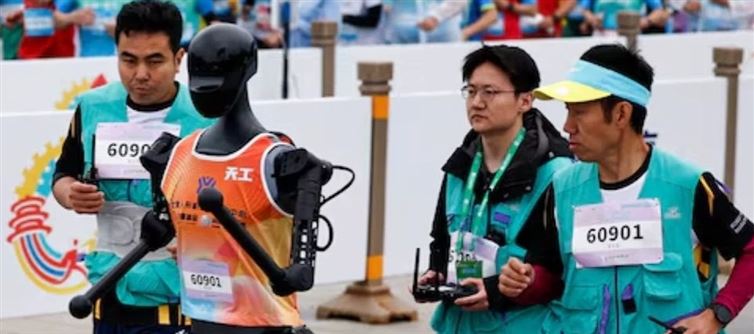
China has fared much better. How? You may have only ever seen human vs robot races in movies. This is becoming a reality in China. For the first time, twenty-one humanoid machines participated in a 21-kilometer half-marathon in beijing alongside human runners.
Teams entered the race from tech companies, research institutes, and universities. Many of these teams had been testing and preparing their robots for weeks before the big day, according to Chinese media. This is the first time that robots were officially allowed to compete alongside humans in a Chinese marathon, despite the fact that they have been spotted in earlier events. Officials likened the competition to a motorcar race, where navigation skills and technical support are just as important as speed.
How is it more than a race?
The robot competition isn't your typical competition. Additionally, it is a component of China's larger endeavor to become the global leader in artificial intelligence and robotics. The country hopes to create excitement about emerging technology by showcasing high-tech machines to the public.
However, some observers are still unsure that this spectacle has many real-world uses. According to Alan Fern, a professor of computer science and robotics at Oregon State University, it's more about proving mechanical endurance than it is about advances in artificial intelligence.
"The robot half-marathon is more of a hardware endurance demonstration," Fern said.
"Chinese businesses have placed a lot of emphasis on showcasing agility skills like dancing, jogging, and walking. These displays are generally fascinating, but they don't show anything about the value of practical labor or any kind of fundamental intellect," he continued.
RULES AND REAL-WORLD CHALLENGES
To ensure fairness and safety, the robot race has its own set of laws. Participation is limited to humanoids who are between 0.5 and 2 meters tall and walk on two feet. Wheeled or multi-legged robots couldn't compete.
After hours of simulation, the real world would push the robots to their limits, according to the organizers. During the race, teams may swap out robots or batteries, but each replacement will result in a 10-minute penalty.
Both autonomous and remote-controlled robots were permitted, although they had to drive carefully throughout the competition. The actual race had a strict 3.5-hour time limit. Penalties may prevent the finisher from winning, and the winner of last place is determined by modified timing.
Winners received cash awards of 5,000 yuan ($697), 4,000 yuan ($558), and 3,000 yuan ($418) in addition to special awards for endurance and inventiveness.
Teams entered the race from tech companies, research institutes, and universities. Many of these teams had been testing and preparing their robots for weeks before the big day, according to Chinese media. This is the first time that robots were officially allowed to compete alongside humans in a Chinese marathon, despite the fact that they have been spotted in earlier events. Officials likened the competition to a motorcar race, where navigation skills and technical support are just as important as speed.
How is it more than a race?
The robot competition isn't your typical competition. Additionally, it is a component of China's larger endeavor to become the global leader in artificial intelligence and robotics. The country hopes to create excitement about emerging technology by showcasing high-tech machines to the public.
However, some observers are still unsure that this spectacle has many real-world uses. According to Alan Fern, a professor of computer science and robotics at Oregon State University, it's more about proving mechanical endurance than it is about advances in artificial intelligence.
"The robot half-marathon is more of a hardware endurance demonstration," Fern said.
"Chinese businesses have placed a lot of emphasis on showcasing agility skills like dancing, jogging, and walking. These displays are generally fascinating, but they don't show anything about the value of practical labor or any kind of fundamental intellect," he continued.
RULES AND REAL-WORLD CHALLENGES
To ensure fairness and safety, the robot race has its own set of laws. Participation is limited to humanoids who are between 0.5 and 2 meters tall and walk on two feet. Wheeled or multi-legged robots couldn't compete.
After hours of simulation, the real world would push the robots to their limits, according to the organizers. During the race, teams may swap out robots or batteries, but each replacement will result in a 10-minute penalty.
Both autonomous and remote-controlled robots were permitted, although they had to drive carefully throughout the competition. The actual race had a strict 3.5-hour time limit. Penalties may prevent the finisher from winning, and the winner of last place is determined by modified timing.
Winners received cash awards of 5,000 yuan ($697), 4,000 yuan ($558), and 3,000 yuan ($418) in addition to special awards for endurance and inventiveness.




 click and follow Indiaherald WhatsApp channel
click and follow Indiaherald WhatsApp channel